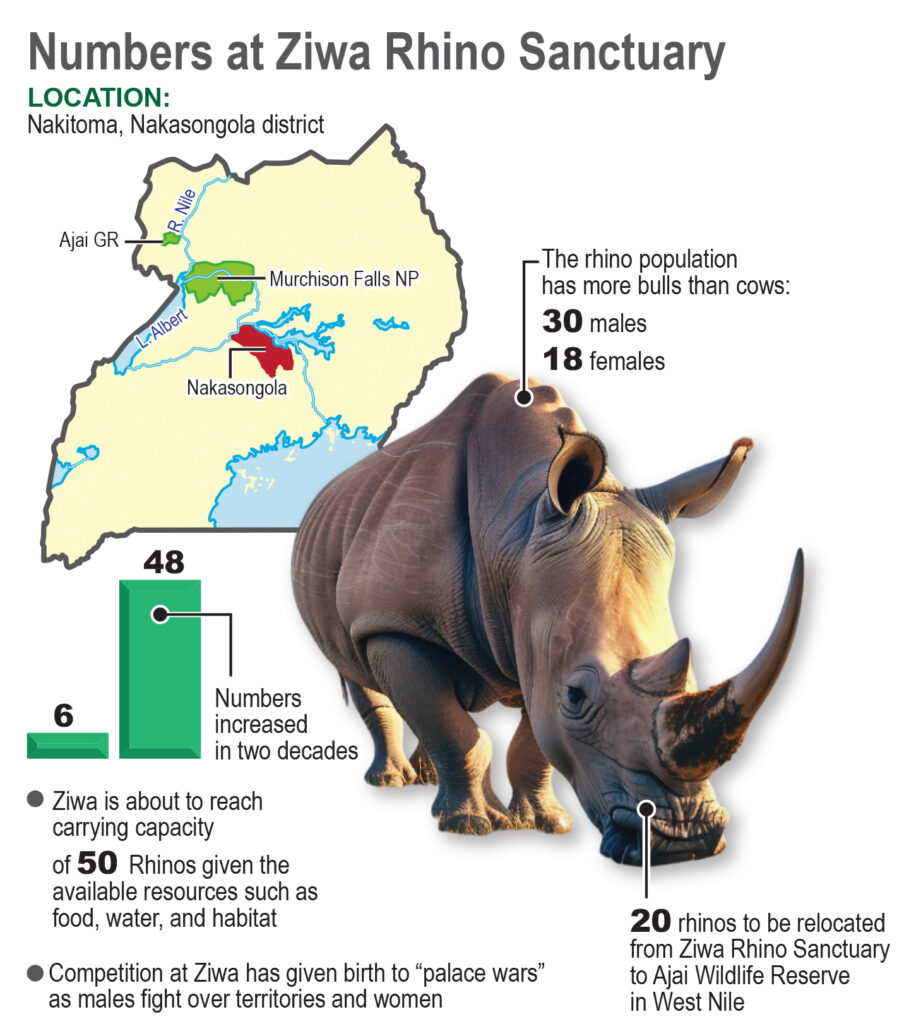Ziwa Rhino and Wildlife Ranch in Nakasongola is known for its wild beauties. This has turned into a sanctuary for breeding Uganda’s rhinos. The ranch has made impressive gains, but faces challenges to return rhinos to their homeland, writes Gerald Tenywa
After 160 km along the Kampala-Gulu Highway, visitors have a chance to see one of the rarest earthly treasures: the globally endangered white rhinos. This is also where the rhinos have been playing ball, increasing their kind from six to 48 in two decades.
For the casual visitors who make stopovers, Ziwa Rhino Sanctuary in Nakitoma, Nakasongola district helps to complete their wild encounters with the big five.
After seeing lions, leopards, elephants and buffaloes in Murchison Falls, tourists have a chance to feast their eyes on the rhinos.
However, there is a lot more than what meets the eye at Ziwa. Anybody who is inquisitive will discover that Ziwa is about to reach carrying capacity, which is estimated at 50. This means that with a population of 48, Ziwa is left with only two more births to hit the ceiling.
Carrying capacity is defined as the maximum population of a species that an environment can sustain indefinitely, given the available resources such as food, water, and habitat, without degrading the environment, according to Biology Online.
As the numbers soar, there is increased competition, which may result in a decline in population. This threat is unfolding at Ziwa, where there are already warning shots.
According to Sharif Nsubuga, the ranger guide in charge of tourism at Ziwa, competition has given birth to “palace wars” as males fight over territories and women. “What you need to know is that this is a small place; it is easy for males to encounter other rhinos,” he says.
“The Males will frequently meet their wives as well as their rivals. As a result, there are intense and frequent fights among the males for dominance, some of which have turned fatal. We have lost two male rhinos after fights. It is common to encounter severely wounded males who are often caught in the fights with other competing males,” he says.
This is also related to another malaise: Ziwa’s rhino population is skewed with more bulls than cows. In terms of numbers, there are 30 males and 18 females at the 70-square-kilometre ranch belonging to Captain Roy. It also means that for every 100 females, there are 167 males.
This, according to Dr. Robert Aruho, a wildlife veterinarian and conservationist, shows that Ziwa Ranch is populated with more rhinos than it can hold.
“What happens with large animal species is that once you exceed carrying capacity, you have a mismatch between the population and nutritious food,” he says, adding that the population is self-regulating.
He also pointed out that males do not carry babies and require fewer resources, including nutritious food to survive. “The population growth is slowing down,” says Aruho, adding that what Uganda is witnessing at Ziwa is not strange among large mammals such as rhinos. particularly in the sanctuaries.
The declining population growth is something which Uganda should avoid since Ziwa was established as a breeding ground for rhinos. Given that each rhino costs between $10,000 and $25,000 in South Africa; it is a big deal to ensure that the rhinos at Ziwa keep producing. more offspring, which can be used to re-wild the protected areas.
Research confirms maleness
It seems being a man is easier than being a woman, according to research findings. In a story produced by Discovery Channel titled, “Boy or Girl? Mother can control outcome, study finds”, confirms animals living in a stressed environment produce more boys than girls.
Discovery Channel, while quoting a new study in the Royal Society B, states, “Mothers can adjust the sex of their unborn children in response to the environment where they live.”
In short, mothers exert far more control than fathers do over whether or not the couple has a son or daughter. The goal is to improve the child’s survival.
Inbreeding
 The pioneers at Ziwa Ranch included two rhinos imported from Disney Animal Kingdom in Florida, US, and four from Solio Ranch in Kenya in 2006.
The pioneers at Ziwa Ranch included two rhinos imported from Disney Animal Kingdom in Florida, US, and four from Solio Ranch in Kenya in 2006.
The two rhinos from the US were Nandi and Hasan. The first offspring at the ranch was Obama, who was fathered by a Kenyan rhino, Taleo, and mothered by Nandi. The pioneer group of six included Moja, Kori and Bella from Kenya.
The rapid expansion of rhinos from six to 48 has been masking a growing problem of inbreeding among the rhinos at Ziwa. “We started with a small genetic base,” says Aruho, adding that the numbers have increased but the genetic base has not changed.
“We need to increase the genetic pool of the rhinos for them to survive in the wild.” He added, “The dominant male always is the one which mates with the females, and this means that the population could be circulating very few genes.”
This is playing out at Ziwa, where one dominant male, Taleo, eliminated two of his sons who were close to the females. Currently, Taleo patronizes the western part of the sanctuary and has left the areas around the headquarters of Ziwa Ranch to his son, Augusto.
However, the growing problems within the population at Ziwa can be turned into opportunities. How? One option is to introduce more rhinos from elsewhere to expand the gene pool, according to Aruho.
But the population at Ziwa has reached carrying capacity. meaning that some rhinos will have to be removed before the introduction of more rhinos can be done. “We can fix the problem by re-introducing part of the population in Ajai Wildlife Reserve,” says Aruho.
Translocation
Dr. James Musinguzi, who is UWA’s executive director, says they are taking back the rhinos to their homeland. “We are taking 20 rhinos to Ajai Wildlife Reserve in West Nile,” says Musinguzi, adding that 28 residents are going to remain at Ziwa. “We want to take unrelated individuals to Ajai,” he says.
UWA’s veterinary doctors, supported by experts, have been undertaking genetic studies of the rhinos and have made recommendations, which will inform the next steps. “We are going to get more rhinos from outside Uganda and mix them with the population at Ziwa and Ajai,” says Musinguzi.
“Uganda is preparing to expand the rhino range to Ajai Wildlife Reserve in the Murchison Falls Conservation Area and Kidepo Valley National Park, restoring them to ecosystems where they once thrived,” he says.
He adds for emphasis, “These expansions will not take away Ziwa – this sanctuary will remain the cradle of rhino conservation in Uganda. A breeding nucleus will continue to be maintained here to secure the future of the species and to ensure a steady population that can support translocations to other landscapes.”
In this way, Ziwa will always stand as the heartbeat of Uganda’s rhino story – a place where they were reborn and nurtured, and from them, they will repopulate our wild.
As rhinos move closer to the promised land, UWA is also preparing ground, including watering holes and pastures to make life easy for the rhinos at Ajai. In addition, the rhinos need an electric fence and highly trained rangers to monitor them all the time.
Extinction, return
The rhinos have been victims of poaching, according to Dr. Patrick Atimnedi, the Senior Manager for Veterinary Services, UWA. “The rhinos are hunted down for their horns,” he says, adding that the horn is used as a status symbol and traditional medicine in the far East (China and Vietnam).
However, the rhino horn is similar to human nails, which are made of a hard protein material known as keratin without any curative properties, according to Atimnedi.
The two species, the northern white rhinos and the eastern black rhinos, became extinct in the 1980s after years of political turmoil and civic unrest. The last rhino in Uganda was seen in 1983.
As peace returned to Uganda, Rhino Fund Uganda was formed in 1997 as an NGO with a mission to reintroduce and breed rhinos, specifically black and white rhinoceroses, back into Uganda. The Rhino NGO teamed up with UWA and other partners to import the two southern white at Uganda Wildlife Education Centre (UWEC) in 2001.
Name a rhino
In the wake of the thriving rhino population and the need to translocate some of them to Ajai, there is a big funding gap. This is expected to be plugged by a fundraising drive known as “Name and Friend a Rhino”.
The campaign will continue, offering every Ugandan and friends across the world an opportunity to be part of this journey. “You can name a rhino, befriend one, or support in your own way,” says Musinguzi. “Every action counts and every contribution, big or small, matters.”
He reveals that this is expected to attract most of the $11 million (Shs40b) to fund the National Rhino Conservation Strategy. “These funds will be ploughed back into conservation, supporting protection, range expansion, community engagement, and the conservation infrastructure needed to secure the future of this species,” says Musinguzi.
Chimp conservationists leading from the front
The government’s call to action has landed on fertile ground at the Jane Goodall Institute (JGI). For sentimental reasons, one of the calves was named after Jane Goodall, a conservation icon of global acclaim before her passing recently.
The nine-month-old calf is a descendant of Nandi, one of the two pioneer rhinos from the US. The Jane Goodall Institute also has its headquarters in the US.
According to JGI’s executive director in Uganda, James Byamukama, Jane Goodall was the first person to name wild animals at Gombe, Tanzania. Goodall led groundbreaking research on chimps at Gombe. So, the conservationists behind the rhino cause are walking in her footsteps.
Also, conservation is building on what Byamukama refers to as “people-centred conservation”, which is an approach that focuses on community involvement as well as local benefits to ensure sustainability.
In short, the story of the rhinos is not ending; it is beginning. “The rhino story is Uganda’s story: one of resilience, unity and hope,” says Colonel (Retired) Tom Butime, the Minister of Tourism, Wildlife and Antiquities.



